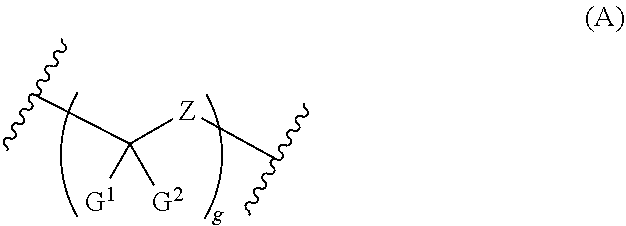Compounds and methods for the treatment of ocular disorders
a technology for ocular disorders and compounds, applied in the field of compound and method for the treatment of ocular disorders, can solve the problems of pain for patients, no approved pharmacological agents are useful, and reduce the quality and/or quantity of ocular disorders
- Summary
- Abstract
- Description
- Claims
- Application Information
AI Technical Summary
Benefits of technology
Problems solved by technology
Method used
Image
Examples
synthesis example 1
Chemical Synthesis Example 1
1-((Isopropoxycarbonyl)oxy)ethyl (2S)-2-(2-(benzofuran-6-carbonyl)-5,7-dichloro-1,2,3,4-tetrahydroisoquinoline-6-carboxamido)-3-(3-(methylsulfonyl)phenyl)propanoate
[0300]
[0301]To a stirred solution of Lifitegrast (250 mg, 0.410 mmol) in anhydrous DMF (5 mL) was added 1-chloroethyl isopropyl carbonate (81.2 mg, 0.490 mmol) followed by potassium carbonate (73.0 mg, 0.530 mmol) and the mixture stirred at 55° C. for 2 hours. The mixture was diluted with EtOAc and washed successively with water followed by sat. brine solution. The organic phase was dried (MgSO4) and the solvent evaporated in vacuo. The residue was dissolved in DMSO and the product purified by reversed-phase preparative HPLC. Fractions containing product were combined and concentrated in vacuo to approximately 1 / 5 of the volume. The mixture was diluted with EtOAc and washed successively with water followed by sat. brine solution. The organic phase was dried (MgSO4), filtered and the solvent eva...
synthesis example 2
Chemical Synthesis Example 2
4-((2S)-3-(1-((isopropoxycarbonyl)oxy)ethoxy)-2-((S)-4-methyl-2-(2-(o-tolyloxy)acetamido)pentanamido)-3-oxopropyl)phenyl 4-carbamoylpiperidine-1-carboxylate
[0302]
[0303]3-[4-(4-carbamoylpiperidine-1-carbonyl)oxyphenyl]-2-[[(2S)-4-methyl-2-[[2-(2-methylphenoxy)acetyl]amino]pentanoyl]amino]propanoic acid (80 mg, 0.134 mmol) was dissolved in anhydrous N,N-dimethylformamide (5.0 mL). 1-Chloroethyl isopropyl carbonate (50 mL, 0.327 mmol) was added and the mixture stirred at 60° C. for 24 hours. N,N-Diisopropylethylamine (80 mL, 0.459 mmol) and 1-chloroethyl isopropyl carbonate (50 mL, 0.327 mmol) were added and the mixture stirred at 60° C. for 2 hours. The solvent was evaporated in vacuo, and the residue partitioned between EtOAc (40 mL) and sat. NaHCO3(aq) (20 mL). The layers were separated and the organic phase washed with sat. brine solution (20 mL), dried (MgSO4), filtered, and the solvent evaporated in vacuo. The crude product was purified by flash chroma...
synthesis example 3
Chemical Synthesis Example 3
1-((tert-Butoxycarbonyl)oxy)ethyl (2S)-2-(2-(benzofuran-6-carbonyl)-5,7-dichloro-1,2,3,4-tetrahydroisoquinoline-6-carboxamido)-3-(3-(methylsulfonyl)phenyl)propanoate
[0304]
Method A:
[0305]To a mixture of Lifitegrast (20 mg, 0.0300 mmol), DIPEA (11 mL, 0.0650 mmol) and DMF (1 mL), under an atmosphere of N2, was added tert-butyl 1-chloroethyl carbonate (7.04 mg, 0.0400 mmol). The reaction mixture was stirred at 60° C. for 48 hours. tert-Butyl 1-chloroethyl carbonate (5.9 mg, 0.033 mmol) and DIPEA (8.9 μL, 0.065 mmol) were added and the reaction mixture stirred at 60° C. for 4 hours. Potassium iodide (5.4 mg, 0.0325 mmol) was added and the reaction mixture stirred at 60° C. for 72 hours. The reaction mixture was diluted with EtOAc (10 mL), and the solution washed successively with H2O (2×5 mL) and sat. brine solution (5 mL). The organic phase was dried (MgSO4), filtered and the solvent evaporated in vacuo. The crude product was then purified by preparative rev...
PUM
| Property | Measurement | Unit |
|---|---|---|
| melting point | aaaaa | aaaaa |
| melting point | aaaaa | aaaaa |
| wt. % | aaaaa | aaaaa |
Abstract
Description
Claims
Application Information
 Login to View More
Login to View More - R&D
- Intellectual Property
- Life Sciences
- Materials
- Tech Scout
- Unparalleled Data Quality
- Higher Quality Content
- 60% Fewer Hallucinations
Browse by: Latest US Patents, China's latest patents, Technical Efficacy Thesaurus, Application Domain, Technology Topic, Popular Technical Reports.
© 2025 PatSnap. All rights reserved.Legal|Privacy policy|Modern Slavery Act Transparency Statement|Sitemap|About US| Contact US: help@patsnap.com



